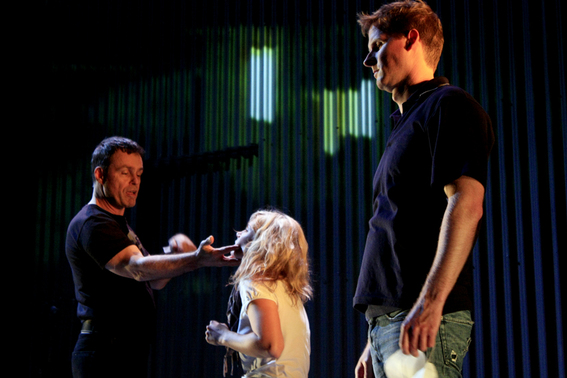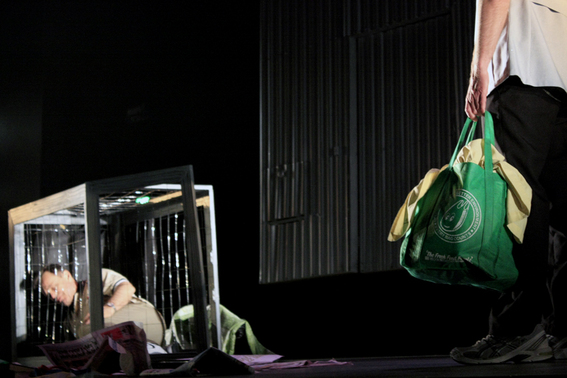Terry Serio and Adam Booth in Blame it on Dapto
4 Plays about Wollongong was commissioned by Merrigong Theatre Company. Each of the plays was radically different but all had to be realised within the same space. The major challenge for the designers was to create an environment that would allow for all of the texts to be seen as one production, yet facilitate them individually.
The War on the Hill and Blame it on Dapto were both set in single rooms, whilst The Sound was set on a cliff overlooking the ocean. The Sameness of the Days was set in eleven different locations, some of which were re-visited several times. If sameness were a short film this wouldn’t have been a problem, however as a live production it was something we had to take into account right from the start.
Adam Booth and Terry Serio in The Sameness of the Days
Set, costumes and props have a lot of roles to fill in a performance, and only one of those is providing information regarding the literal setting of the action (assuming the text has a literal location). Simon Greer conceived a set that was responsive to both the informational and emotional needs of the texts.
The design consisted of two main elements: An angled, raked stage platform and a corrugated ‘wall’ sitting upstage. The wall was to be hung so it would float completely off the deck, the rake below seen to be continuing on upstage. This helped to give the impression of two separate objects that we could manipulate into becoming different environments, rather than a pre-assembled ‘room space’ with a wall and floor.
The surface of the wall covered in corrugated plastic sheets, treated to look like sheet metal under front lighting. Use of semi-transparent material meant that the wall could be backlit and would glow. Initially I was worried that the corrugations would make a mess of anything I projected on it, however we tested this early on and found that it wasn’t the case. Finally a door in the wall covered our entrance and exit requirements.
Terry Serio, Adam Booth and Clare Bowen in The Sound
For The War on the Hill and Blame it on Dapto the costumes and props did most of the talking for us in terms of time/place, portraying a WWII era Bulli miners cottage and a small, run down house in Modern Dapto respectively. The corrugated back wall of the set also helped to give us some ‘local character’ in these two. In both I used side light to bring out the shape of the corrugation.
The rapid locale changes in Sameness of the Days is what originally brought us around to the idea of projection. I’m a big fan of what projection can do, although I feel it is often misused by directors attempting to turn live performance into film. For me one of the biggest challenges of the whole project was getting Sameness from place to place, perhaps with a certain filmic quality, but without caving in to the temptation of portraying all the locations literally.
Adam Booth and Terry Serio in Blame it on Dapto.
From my perspective as AV designer the success of Sameness hinged upon two conditions: Firstly that the images gave enough information to establish the location, but were otherwise textural, working with the lighting to enhance the space. For a scene set in one particular local nightclub I used a close up image of flashing lights bouncing off of a water-damaged ceiling tile. Combined with a deep bass sound cue it instantly said both seedy and nightclub, but remained sufficiently flexible as to be an ’emotionally useful’ part of the environment of the rest of the scene, rather than a picture that had done its job. Where I did used long-shots I was fortunate enough to be working on a project that focused on local stories and was presented to a local audience. Particular images, for instance a shot up the main street towards the hospital, were instantly recognisable as belonging to a certain district and recalling ideas about certain local businesses in that area.
The second key component to the AV was the target surfaces. When working with projectors it’s always important to me that the set doesn’t seem to be ‘missing something’ when there isn’t an image. I hate the idea of having a blank screen sitting onstage. Initially (before the set was locked in) I suggested projecting onto multiple flat surfaces in the space, the use of different surfaces in each scene precluding any single one become the ‘main screen’. (see a diagram here) This idea carried over into the final design where there was a secondary projection on the table/box object during Sameness. This secondary image was linked in to the first one, usually another close up. These images augmented each other to lend to the idea that the actors were in the scene with the projection, rather than just acting in front of a two dimensional projected backdrop.
Terry Serio, Clare Bowen and Adam Booth in The Sameness of the Days
It was decided that The Sound was to move away from the literalness of the other works, building up to a cathartic, emotional ending for the show. I was very happy with how the lighting turned out for The Sound. The entire thing ran as one fifteen minute long cue, plus some complicated timing with part cues. Overall it gave the impression of a long, red, sun-rise, starting in near darkness and finishing with a really strong low-angle light. Liberal use of booms gave it a lot of impact, although it meant the actors had to be very conscious of where the light for their faces was coming from. Tricky use of part cues allowed me to make sure certain critical lights were on before others, helping cover faces as the actors moved through the scene.
Terry Serio in The Sound
For projection control I built a media server in vvvv. In the past I had experienced sluggish performance interfaci
ng server with console via an Enntec DMX USB PRO, but with Merrigongs new ETC Ion I could now get the console and the computer to talk directly via ART-NET. The speed was improved dramatically. For 4 plays I programmed full keystoning for each layer, allowing me to fit a clip to any non-curved surface within the ‘view’ of the projector. One thing I learnt this time round was that the play channel needs a ‘play on fade up’ mode as I had a lot of difficulty getting the clip to stay cued when the desk would do an automatic move-while-dark, preparing the clip to be played in the next scene. It would set the clip to the right position, colour, file etc… but would also start it playing, so when it faded in in the next scene it could be at any point in it’s playback. A play-on-fade feature would have saved me some grief. Although perhaps by next time there will be a better option than DMX control of media.
Terry Serio and Adam Booth in Blame it on Dapto
I was generally happy with the ION (its timing control was very handy in The Sound) but found it to be a real pain if you are making your own fixture profiles, particularly when you’re trying to do something a bit different. You can’t rename parameters and they are permanently assigned to certain palettes, meaning that I was either forced to stick with ETC’s model of how I should control my media, or I could do it my way but with non-sensical names (I.E there weren’t enough XY parameters for keystoning in the focus palette to name each X1, Y1, X2, Y2, X3, Y3, X4, Y4, so they had to be Pan, Tilt, Pan2, Tilt2, X, Tilt 3 and Y, Tilt 4. There were enough in the beam palette, but I wanted beam palettes to exclusively control file and content rather than position) In the end I chose the latter because having accurate palette control was better than having accurate names.
Liz Burch and Clare Bowen in The Sameness of the Days
4 Plays about Wollongong is a result of the dedicated team at Merrigong Theatre Company. It’s truly fantastic that a regional company like Merrigong is in a position to commission and fund a high quality professional production that celebrates the local community in such a way. The audience response was overwhelming and I’m extremely grateful to have been part of the project. I look forward to seeing the team again somewhere down the road.
For those interested find the plan here.
Full credits here.








